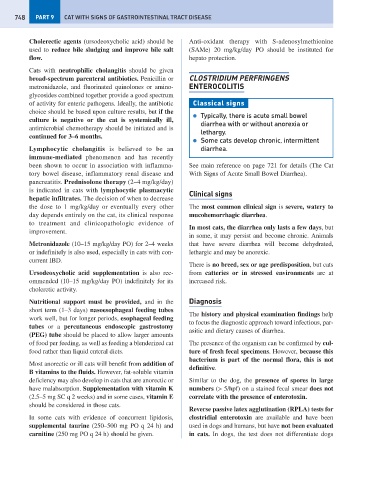Page 756 - Problem-Based Feline Medicine
P. 756
748 PART 9 CAT WITH SIGNS OF GASTROINTESTINAL TRACT DISEASE
Cholerectic agents (ursodeoxycholic acid) should be Anti-oxidant therapy with S-adenosylmethionine
used to reduce bile sludging and improve bile salt (SAMe) 20 mg/kg/day PO should be instituted for
flow. hepato protection.
Cats with neutrophilic cholangitis should be given
broad-spectrum parenteral antibiotics. Penicillin or CLOSTRIDIUM PERFRINGENS
metronidazole, and fluorinated quinolones or amino- ENTEROCOLITIS
glycosides combined together provide a good spectrum
of activity for enteric pathogens. Ideally, the antibiotic Classical signs
choice should be based upon culture results, but if the
● Typically, there is acute small bowel
culture is negative or the cat is systemically ill,
diarrhea with or without anorexia or
antimicrobial chemotherapy should be initiated and is
lethargy.
continued for 3–6 months.
● Some cats develop chronic, intermittent
Lymphocytic cholangitis is believed to be an diarrhea.
immune-mediated phenomenon and has recently
been shown to occur in association with inflamma- See main reference on page 721 for details (The Cat
tory bowel disease, inflammatory renal disease and With Signs of Acute Small Bowel Diarrhea).
pancreatitis. Prednisolone therapy (2–4 mg/kg/day)
is indicated in cats with lymphocytic plasmacytic
Clinical signs
hepatic infiltrates. The decision of when to decrease
the dose to 1 mg/kg/day or eventually every other The most common clinical sign is severe, watery to
day depends entirely on the cat, its clinical response mucohemorrhagic diarrhea.
to treatment and clinicopathologic evidence of
In most cats, the diarrhea only lasts a few days, but
improvement.
in some, it may persist and become chronic. Animals
Metronidazole (10–15 mg/kg/day PO) for 2–4 weeks that have severe diarrhea will become dehydrated,
or indefinitely is also used, especially in cats with con- lethargic and may be anorexic.
current IBD.
There is no breed, sex or age predisposition, but cats
Ursodeoxycholic acid supplementation is also rec- from catteries or in stressed environments are at
ommended (10–15 mg/kg/day PO) indefinitely for its increased risk.
choleretic activity.
Nutritional support must be provided, and in the Diagnosis
short term (1–3 days) nasoesophageal feeding tubes
The history and physical examination findings help
work well, but for longer periods, esophageal feeding
to focus the diagnostic approach toward infectious, par-
tubes or a percutaneous endoscopic gastrostomy
asitic and dietary causes of diarrhea.
(PEG) tube should be placed to allow larger amounts
of food per feeding, as well as feeding a blenderized cat The presence of the organism can be confirmed by cul-
food rather than liquid enteral diets. ture of fresh fecal specimens. However, because this
bacterium is part of the normal flora, this is not
Most anorectic or ill cats will benefit from addition of
definitive.
B vitamins to the fluids. However, fat-soluble vitamin
deficiency may also develop in cats that are anorectic or Similar to the dog, the presence of spores in large
have malabsorption. Supplementation with vitamin K numbers (> 5/hpf) on a stained fecal smear does not
(2.5–5 mg SC q 2 weeks) and in some cases, vitamin E correlate with the presence of enterotoxin.
should be considered in those cats.
Reverse passive latex agglutination (RPLA) tests for
In some cats with evidence of concurrent lipidosis, clostridial enterotoxin are available and have been
supplemental taurine (250–500 mg PO q 24 h) and used in dogs and humans, but have not been evaluated
carnitine (250 mg PO q 24 h) should be given. in cats. In dogs, the test does not differentiate dogs

